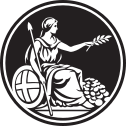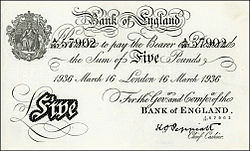The first £5 notes were hand drawn and were issued in 1793. They are copyright to the bank of England.
It was one of my tasks to draw them up.
England's crushing defeat by France, the dominant naval power, in naval engagements culminating in the 1690 Battle of Beachy Head, became the catalyst to England rebuilding itself as a global power. England had no choice but to build a powerful navy if it was to regain global power. As there were no public funds available, in 1694 a private institution, the Bank of England, was set up to supply money to the King. £1.2m was raised in 12 days; half of this was used to rebuild the Navy.
The Bank's original home was in Walbrook in the City of London, where during the building's reconstruction in 1954 archaeologists found the remains of a Roman temple to Mithras (Mithras was – rather fittingly – worshipped as being the God of Contracts); the Mithraeum ruins are perhaps the most famous of all twentieth-century Roman discoveries in the City of London and can now be viewed by the public.
The Bank of England moved to its current location on Threadneedle Street, and thereafter slowly acquired neighbouring land to create the edifice seen today. Sir Herbert Baker's rebuilding of the Bank of England, demolishing most of Sir John Soane's earlier building was described by architectural historian Nikolaus Pevsner as "the greatest architectural crime, in the City of London, of the twentieth century".
When the idea and reality of the National Debt came about during the 18th century this was also managed by the bank. By the charter renewal in 1781 it was also the bankers' bank – keeping enough gold to pay its notes on demand until 26 February 1797 when war had so diminished gold reserves that the government prohibited the Bank from paying out in gold. This prohibition lasted until 1821.
£1,000,000 and £100,000,000
The banknotes issued by the banks in Scotland and Northern Ireland are required to be backed pound for pound by Bank of England notes. Due to the large number of notes issued by these banks it would be cumbersome and wasteful to hold Bank of England notes in the standard denominations. High denomination notes, for £1 million ("Giants") and £100 million ("Titans"), are used for this purpose. These resemble simple IOUs and bear no aesthetic design features. [25] They are used only internally within the Bank and are never seen in circulation.[25]
However the need for these large notes has been obviated by section 217(2)(c) of the Banking Act 2009.

Bank of England Threadneedle Street, London, England, U.K.

The Bank of England, which is now the Central Bank of the United Kingdom, has issued banknotes since 1694.
Parent company EMI
KYLIE / COLDPLAY / TINIE TEMPAH / CHIDDY BANG / THE CHEMICAL BROTHERS / ELIZA DOOLITTLE / THE GOOD NATURED /PET SHOP BOYS / MORNING PARADE / SKY FERREIRA / BAT FOR LASHES / BLUR / LATE OF THE PIER / JONSI / SIGUR ROS / RICHARD ASHCROFT / GORILLAZ / THE VERVE / BEASTIE BOYS / LADY ANTEBELLUM / LCD SOUNDSYSTEM
| Reserves | £7,334,000,000 (in gold)
£229,599,000,000 (total assets) [1] |
|---|---|
| Base borrowing rate | 0.5%[2] |
| Website | http://www.bankofengland.co.uk |
| Succeeded by | Currency Commission (Republic of Ireland only) |
£5 note
The first Bank of England £5 note was issued in 1793 in response to the need for smaller denomination banknotes to replace gold coin during the French Revolutionary Wars (previously the smallest note issued had been £10). The 1793 design, latterly known as the "White Fiver" (black printing on white paper), remained in circulation essentially unchanged until 21 February 1957 when the multicoloured (although predominantly dark blue) "Series B" note, depicting the helmeted Britannia was introduced. The old "White Fiver" was withdrawn on 13 March 1961.
£10
The first ten pound note was issued in 1759, when the Seven Years' War caused severe gold shortages. Following the withdrawal of the denomination after the Second World War, it was not reintroduced until the Series C design on 21 February 1964 produced the brown ten pound note. The Series C note was withdrawn on 31 May 1979. The Series D pictorial note appeared on 20 February 1975, featuring nurse Florence Nightingale (1820–1910) on the reverse, plus a scene showing her work at the army hospital in Scutari during the Crimean War.
Parlophone is a record label that was founded in Germany in 1896 by the Carl Lindström Company as Parlophon. The British branch was formed in 1923 as "Parlophone" which developed a reputation in the 1920s as a leading jazz label. It was acquired in 1927 by the Columbia Graphophone Company which later became EMI. George Martin joined in 1950 as assistant label manager, taking over as manager in 1955. Martin produced and released a mix of product including comedy recordings of The Goons, the pianist Mrs Mills, and teen idol Adam Faith. In 1962 Martin signed rising new Liverpool band The Beatles. With Cilla Black, Billy J. Kramer, the Fourmost, and contemporary Mancunian band The Hollies also signed to the label, Parlophone in the sixties became one of the world's most famous and prestigious record labels.
For a long time Parlophone claimed the best selling UK single "She Loves You", and the best selling UK album Sgt. Pepper's Lonely Hearts Club Band. The label also achieved placement of seven singles at #1 during 1964, when it also claimed top spot in the album charts for 40 of the 52 weeks during that year.

An Operation Bernhard forgery of the Bank of England £5 note.
During World War II the German Operation Bernhard attempted to counterfeit various denominations between £5 and £50, producing 500,000 notes each month in 1943. The original plan was to parachute the money into Britain in an attempt to destabilise the British economy, but it was found more useful to use the notes to pay German agents operating throughout Europe. Although most fell into Allied hands at the end of the war, forgeries were frequently appearing for years afterwards, so all denominations of banknote above £5 were subsequently removed from circulation.
All old Bank of England notes remain exchangeable for current notes for ever. Forgeries (including Bernhard notes) will, however, be retained and destroyed by the Bank. If a suspect note is found to be genuine a full refund by cheque will be made. However, it is a criminal offence to knowingly hold or pass a counterfeit bank note without lawful authority or excus

